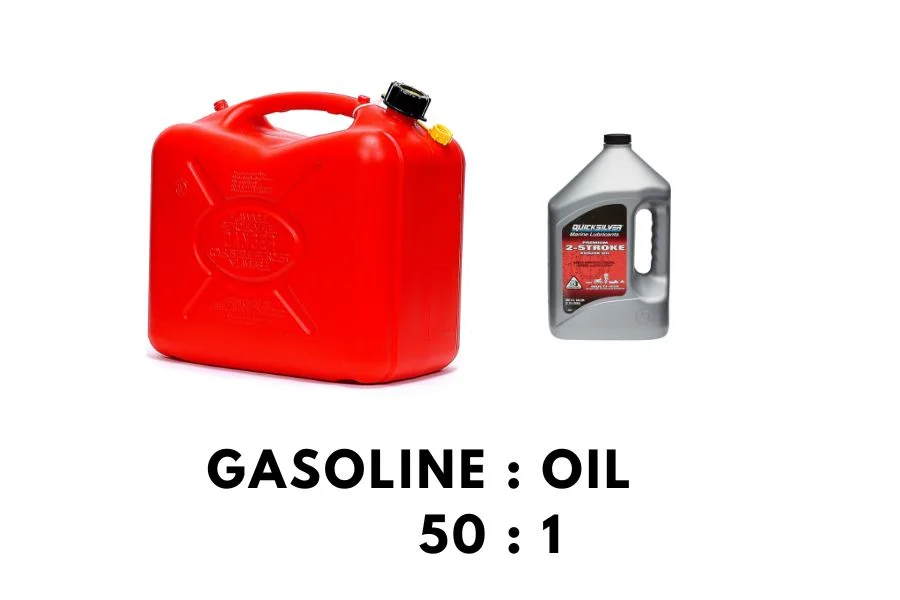The chainsaw is one of the most used cutting tools in woodworking. So when you use it, you should know how much gas and oil should be mixed. There are a few mixing ratios that you can use to minimize fuel consumption and increase performance well. So let’s see in detail the chainsaw gas mix ratios with the correct proportion.
Most chainsaws need a 50:1 fuel/oil mix ratio (2.6oz oil per gallon) for the 2-stroke engines. Some chainsaws require a 40:1 fuel/gas ratio (3.2oz oil per gallon). In order to reduce the inside friction and heat, older chain saws use a 30:1 fuel-oil ratio.
The gas mixing ratio depends on the type of chainsaw and cc. When you mix oil with gas, you should have fresh fuel (gas) which is not older than 06 weeks. So let’s see, how to mix the oil with fuel in chainsaws properly with its effect. So let’s keep reading on.
Why Do Chainsaws Need a Gas Oil Mixture?
A chain saw needs a proper gas-to-oil mix proportion (50:1), which helps to move engine parts smoothly in a 2-stroke chain saw engine in order to reduce the machine heat and protect the piston and crankcase from getting damaged. And also, using only gasoline causes to chainsaw’s low performance, and sometimes your chainsaw’s lifetime will be reduced. So you had better use a proper gas mixture on your chain saw every time.
What Is 50 To 1 Gas Oil Mixture?

When your chainsaw’s manufacturer recommends a 50:1 fuel-to-oil mix ratio, you need 50 parts of gasoline need to mix with one part of oil.
If you mix one liter of fuel at a 50:1 ratio, you have to add 20 milliliters of oil. It is easy to calculate the 50:1 fuel-to-oil ratio.
When you move to other gas mix ratios such as 40:1, 32:1 and 25:1, the below conversations will help.
- 1 gallon = 128 ounces, So 1 gallon needs 2.6 ounces of oil
- 1 litre = 1000 millilitres, So 1 litre needs 20 millilitres of oil
Which Oil Need To Mix With Chainsaw Fuel?

When we mix oil with fuel, we can see, many types of oil in the market. So let’s see, how to choose the suitable oil which is highly compatible with the chainsaw engine.
- Simple mineral oil – Derives from fossil oils.
- Synthetic oil – Mix mineral oils and additives such as detergent and stabilizers to burn better
When you use gasoline, it should have a minimum of 89% of octane and no more than 10% ethanol content. If your octane rating is below 89%, it may increase the engine temperatures. When the ethanol content is more than 10% will cause running problems and major damage in the engine. If you use various ethanol-content fuels, you should adjust the carburettor because it affects the engine speed. You should shake well after you mix the oil with the fuel.
Synthetic oil is really good for chainsaws. Because it produces lower deposits and emissions due to lower ash content, sometimes, mineral oils can contain non-lubricants and solvents and additives that allow easier gasoline mixture. But it causes a higher amount of emissions, and sometimes those can harm the environment.
How Many CC Chainsaw Do I Need?
Chainsaw Gas Mix Ratio Chart
Chainsaw engines are 2-stroke engines. So we should use additional lubricants with fuel in order to control heat and friction inside. So, mostly, the gas mix ratio for the chainsaws is 50:1. You can follow the table below when you mix oil with gas.
| Fuel Amount (Gallon or Ltr)* | Oil amount in mixture Ounces (oz) | Oil amount in mixture milliliters (ml) |
| 1 | 2.6 | 20 |
| 2 | 5.2 | 40 |
| 3 | 7.8 | 60 |
| 4 | 10.4 | 80 |
| 5 | 13 | 100 |
| 6 | 15.6 | 120 |
| 7 | 19.2 | 140 |
| 8 | 21.8 | 160 |
| 9 | 24.4 | 180 |
| 10 | 26 | 200 |
When you mix, you should use a standard unit such as Gallon – Ounces or Liter – Milliliters
STIHL Chainsaw Fuel Mix Ratio
For STIHL chainsaws, all models generally use a 50:1 mixing ratio. In some special cases, this will vary. So I strongly suggest you check the manufacturer’s manual before you use it.
- 1-liter gasoline mix with 20 milliliters of STIHL oil,
- 5l with 100 ml
- 10 l with 200ml.
Can You Use Only Gasoline In Chainsaw?

You can’t use only gasoline in chainsaws because the chainsaw engine is a 2-cycle engine. We called this is a 2-stroke engine. When only gasoline is combusting inside lot of heat is generated. And there will be high friction. Due to this, engine heat will go up and inside parts, rubbers, bushes, and rings can be melted easily due to heat.
So do not let destroy the engine without using only gasoline. By accident, if you fill the chainsaw in a gas station, don’t forget to mix the oil (2T).
What Happens If I Mix Too Much 2-Stroke Oil?

When you add too much oil to the fuel mixture for chainsaws, You can see smoky exhaust leaking out of the muffler and sometimes losing power. So those problems can be fixed easily by replacing fuel in the tank. So, always mix the fuel and oil according to the recommended ratio.
Additionally, when you add too much 2-stroke oil in your chainsaw, carbon and oil will be deposited. So it clogs the whole system, and air can’t move in and out. So, the engine will overheat rapidly.
You will get a huge carbon build-up due to too much oil right on the piston and exhaust port, and it’s eventually going to break off, and it’s going to get stuck between the piston and cylinder, it is causing the piston and cylinder’s long run score up. So most suitable to use a manufacturer guide and a suitable mixing ratio like 50:1, 40:1, or 32:1 as your manufacturer guide.
2 Stroke vs 4 Stroke Chainsaw: Which One You Need?
Can you Fill Chainsaw Directly from Gas Stations?
You should not fill chainsaws directly from gas stations. Because fuels in the gas station include ethanol and olefin. Ethanol can damage chainsaw engines over time. Olefin can produces a gummy kind of residue and varnish kind of stuff in your carburettor and damages your carburettor. It’s usually recommended to use ethanol-free gasoline for chainsaws. So, it’s better to buy gasoline and mix it with the 2-stroke oil in a separate can, then use this can to fill your chainsaw.

